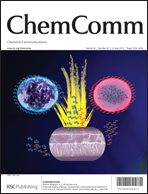Antiaromatic planar cyclooctatetraene: a strategy for developing ambipolar semiconductors for field effect transistors†
Abstract
Tetra[2,3-thienylene] planarised by sulphur bridges and radially π-extended with (triisopropylsilyl)ethynyl groups had a narrow HOMO–LUMO gap due to the antiaromatic cyclooctatetraene core, and its single crystal FET device exhibited ambipolar characteristics with hole and electron mobilities of up to 0.40 and 0.18 cm2 V−1 s−1, respectively.


 Please wait while we load your content...
Please wait while we load your content...